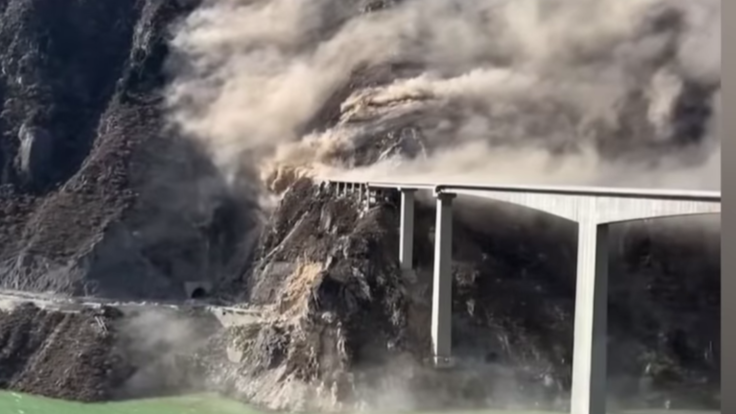Shock as Brand-New Chinese Bridge Crumbles Into Gorge Just Months After Opening
The 758-metre Hongqi Bridge in Sichuan, hailed as a feat of modern engineering, plunged into a gorge after cracks and slope failures appeared—no casualties reported.

A major infrastructure failure in western China has sparked national outrage after the 758-metre Hongqi Bridge in Maerkang, Sichuan Province, collapsed into a gorge only months after it opened.
The incident has raised serious questions about construction oversight, engineering standards, and the risks of rapid development in the country's mountainous west.
The bridge, which was part of a national highway network linking central China to Tibet, had been hailed as a symbol of modern infrastructure expanding into the country's rugged west.
Collapse After Warning Signs
Authorities in Maerkang had already closed the bridge to traffic on Monday after workers detected cracks on nearby road surfaces and signs of ground movement on the slope supporting the right bank of the structure, according to Reuters.
On Tuesday afternoon, as pressure from the unstable slope increased, a large portion of the approach ramp and roadbed gave way, sending clouds of dust and debris into the river valley, according to The Guardian.
Fortunately, there were no vehicles or pedestrians on the bridge at the time, and no casualties were reported, Reuters added.
Engineering Ambition Meets Treacherous Terrain
Completed earlier this year by the state-owned Sichuan Road & Bridge Group, the Hongqi Bridge was a key link in a highway system connecting Sichuan to Tibet.
Spanning 758 metres and standing 625 metres above the gorge floor, it was hailed as a triumph of modern Chinese engineering. However, the region's volatile geology — prone to earthquakes, landslides, and heavy rainfall — made the site one of the most challenging for builders.
'Just months in use and it's fallen apart — that's a red flag for how we approach projects in terrain like this,' a construction-risk analyst told Newsweek. The Guardian described it as one of the region's ambitious transport projects.
What Went Wrong?
Preliminary investigations suggest that a combination of slope instability, shifting soil, and potential design or construction weaknesses may have contributed to the collapse.
NDTV reported that the area's geology had already been identified as unstable during early feasibility studies, but experts fear those warnings may have been downplayed to meet tight completion deadlines.
The disaster follows a string of similar infrastructure failures. In August, a railway bridge under construction in Qinghai Province collapsed, killing at least 12 workers, according to AP News.
Analysts warn these incidents reveal growing pressure on local authorities to deliver rapid, high-profile projects, sometimes at the expense of safety and quality control.
Human Impact and Local Reaction
While no lives were lost, the bridge's failure has dealt a blow to local communities that had hoped for better transport access and economic growth.
'We were told this bridge would bring our villages closer to markets in Lhasa,' a truck driver told IBTimes UK. 'Now we're stuck again.'
Residents told The Guardian they had heard 'mountain rumblings' and seen cracks forming hours before the collapse, prompting many to flee the area.
The incident has since triggered widespread online discussions on China's social media platforms, where users questioned why such an expensive project could fail so soon after completion.
Broader Implications for China's Infrastructure Strategy
China has long relied on large-scale infrastructure projects to drive growth in its inland regions, but the collapse of the Hongqi Bridge has renewed scrutiny of construction oversight.
'A bridge that falls apart after months opens the question: was speed more important than resilience?' an infrastructure commentator told Newsweek.
Analysts said the incident could become a cautionary tale for China's ongoing Belt and Road projects, which often involve building in similarly challenging terrain abroad.
They warned that without stronger regulation and independent inspections, such failures could undermine public confidence in Beijing's infrastructure model.
What Happens Next
Investigators from regional and national agencies have sealed off the site and begun a complete structural and geological probe. Reuters reported that the contractor has removed promotional materials about the bridge from its website while awaiting the outcome of the investigation.
Reconstruction, experts say, will likely require reinforcing the slope foundations and redesigning sections of the bridge — a process expected to take months and cost millions.
As China seeks to demonstrate its engineering might, the Hongqi Bridge collapse stands as a stark reminder that ambition without caution can turn triumph into tragedy overnight.
© Copyright IBTimes 2025. All rights reserved.




















